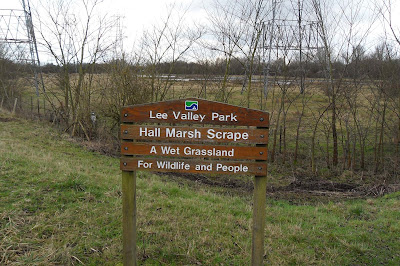Lee Valley love thing

Fortunately there was more wildlife than people here today.
I guess I’ve always had a love affair with the Lee Valley. It was the first 'proper' nature reserve I visited once I had re-found the temptress that is birding. The area is diverse in habitat and sometimes surprising in the quality of the birds. Recent years have brought Paddyfield Warbler, Red-footed Falcon, Savi’s Warbler and Spotted Crake to the valley but pride of place goes to one of Britain’s rarest birds, the Bittern. Around 10% of Britain’s winter population spend their time in the pockets of reedbed that now form a special habitat born out of these now disused gravel pits.

View from the Bittern Watchpoint.
I arrived at the watchpoint around 9am. It was another bitterly cold day and the sky was dark and flat which doesn’t help the photography you know. Now, a couple of these Bittern chaps had been seen over the past couple of days but one thing you need to know about them is that they are 1. very secretive 2. have an identical pattern to reeds and 3. can sit in the middle of the reeds for hours, well, it feels like hours.

A coot. Not a bittern, I know.
From the hide, there were a pair of little grebe and few coot and moorhen. To be honest, there isn’t anything more frustrating than just sitting there with half a hope that there may just be a bittern there although in the back of your mind, you know it may not show for a couple of hours or even at all. The decision most people make to stay, just in case a bird shows, tells me a lot about the hold these heron-like birds have on the birdwatching community.
I dropped my gloves and bent to pick them up. I missed the bittern. Someone called to say it had crossed a channel between two clumps of reedbed and had disappeared again. I wasn’t happy but at least I knew a bird was there and roughly where it was. A water rail came out from the reeds appearing to walk on water – never get bored with these characters.
Then came the telltale sign. Some of the reeds were moving in an unnatural way. Of course, the reeds move with the breeze but a few stems were moving in all directions. A few seconds later, the bittern appeared, perhaps for only 5 seconds but it was clear of the reeds and this hunched old man-like bird worked its way across a clear channel of water and into the next swathe of reed. Unfortunately, I didn’t have time to catch it on camera but who cares? Well I did a bit. Two hours for 5 seconds worth of bittern, marvelous.

Drake Goldeneye.
From here, I set off towards Holyfield Lake. This is a huge expanse of water that is used by a sailing club which can sometimes hinder birdwatching if a lot of boats are taken out. There were a good number of wildfowl on the lake including tufted duck, gadwall, goldeneye ( 2 drakes and 4 ducks) and a (redhead) smew, a small wintering sawbill that stole the show.

Redhead Smew.
In the surrounding woodland, 3 bullfinch were seen as well as goldfinch, great tit, great spotted woodpecker and a dramatic fly through of a female sparrowhawk. A walk up to Hayes Hill farm, produced winter thrushes, redwing and fieldfare and the regular sight of Egyptian geese in amongst the Canada geese.

Egyptian Goose.
Next stop was Hooks Marsh Pit. This leads up to Hall Marsh Scrape and hopefully, a few lapwing and other waders. Sure enough, there were many lapwing, something around the 100 mark but very little else in terms of waders. There were shoveler, wigeon, grey heron and a single shelduck. While on Bowyer Water, another redhead smew showed well.

Lapwings take flight.

Grey Heron.
Working my round in a huge circle back towards the car park, the first rays of the day shone through. A bird flew into a section of grassland. A green woodpecker. Up to now, the shots I had taken were fairly poor. It’s amazing what a little bright light can do to a shot. The woodpecker seemed unconcerned by me but I was still a little way from the bird and didn’t expect to get any decent shot. Although it’s not great, I was pleased to get it even with a blurred fence in the foreground.

Green woodpecker.
Lastly, on the way back I found a drake smew. It was on Hooks Marsh Lake and although the shot is rubbish, it really is a most photogenic bird. Hopefully next winter (yes I do hope this winter is nearly over) I can get a better image.

Drake smew. (He’s the white one with the black eye!)



Comments
Post a Comment